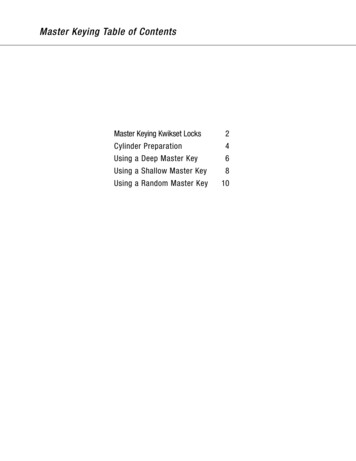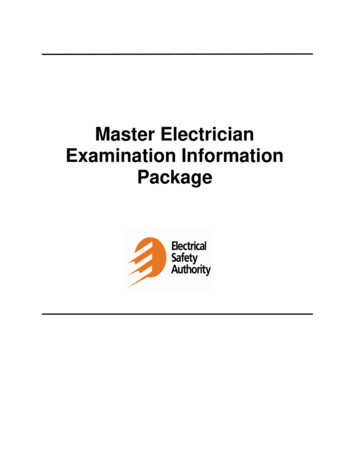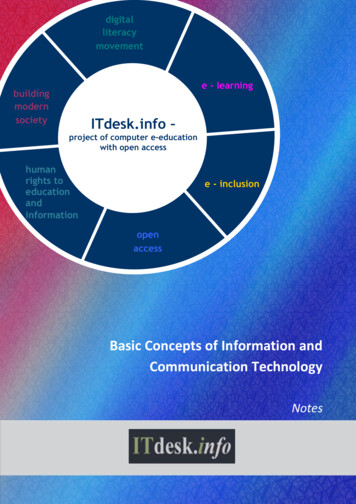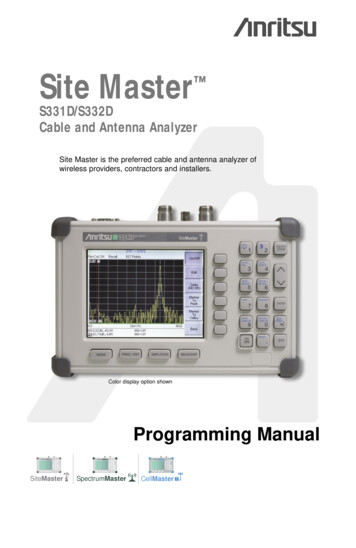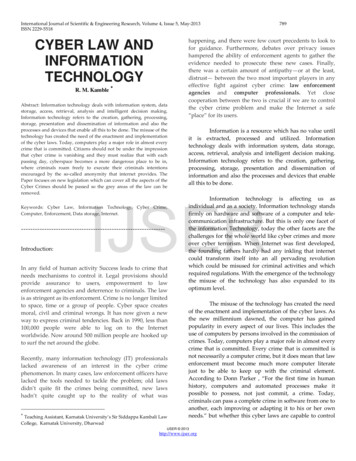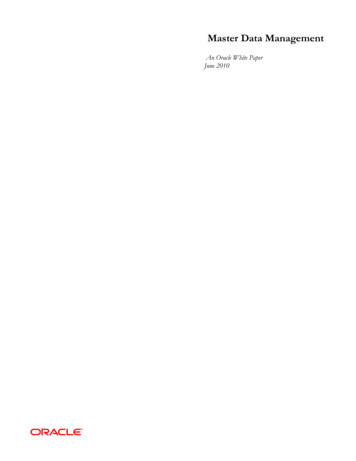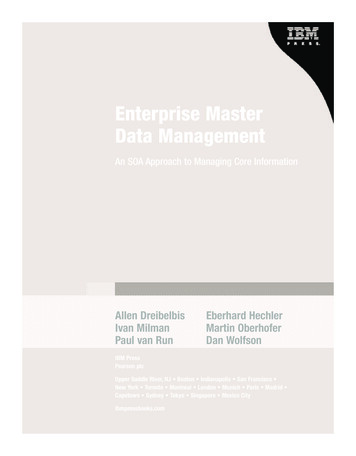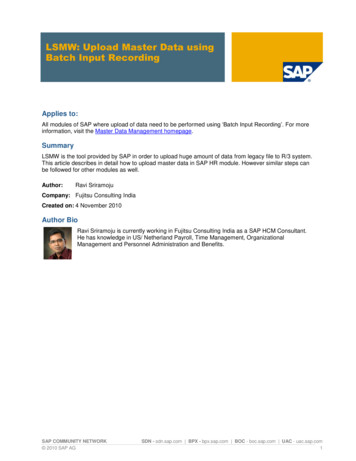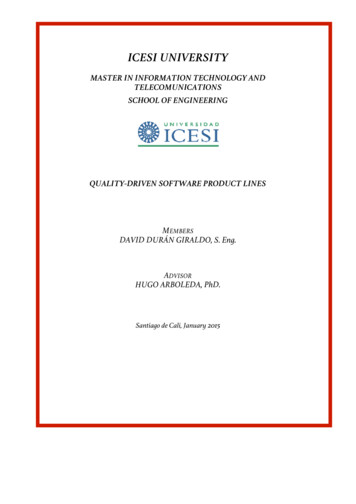
Transcription
ICESI UNIVERSITYMASTER IN INFORMATION TECHNOLOGY ANDTELECOMUNICATIONSSCHOOL OF ENGINEERINGQUALITY-DRIVEN SOFTWARE PRODUCT LINESMEMBERSDAVID DURÁN GIRALDO, S. Eng.ADVISORHUGO ARBOLEDA, PhD.Santiago de Cali, January 2015
TABLE OF CONTENTSAbstract . 51. Introduction . 62. Background . 72.1 Quality Attributes . 72.2 Software Architecture . 82.2.1 Tactics . 92.2.2 Reference Architectures. 102.3 Enterprise Software Applications . 112.4 Model Driven Engineering . 112.5 Software Product Line Engineering . 132.6 Related Work. 143. Case Study . 174. Proposal . 21General Process for Product Derivation . 214.1. Define the Software Product Line Scope . 224.1.1. Functional Scope Definition . 224.1.2. Quality Scope Definition . 244.2. Determine Design Decisions of Product Line Members . 294.2.1. Identify Enterprise Design Patterns to Promote Variants from the QAs Model. 294.2.2. Reference Architecture Definition . 314.3. Perform Code Generation . 544.3.1. Constructing the Product Line Member Concrete Architecture . 554.3.2. General Delegation Strategy . 584.3.3. Concrete Generation Strategy . 645. Technologies Involved in Product Line Members Derivation . 765.1 Create a Model Based on the DMM . 775.2 Select a Configuration From the QAs Variability Model . 795.3 Execute Generation Workflow . 816. Conclusions . 817. Bibliography . 82Annex 1. Query Declaration example . 89Annex 11. Normal Time Execution Implementation . 89Annex 111. Medium Time Execution Implementation . 89Annex v1. High Sync Time Execution Implementation . 90Annex V. High Async Time Execution Implementation . 912
List of FiguresFigure 1. Use Cases of the SPL for Projects Management. 19Figure 2. Use case patterns of the SPL of enterprise applications . 20Figure 3. Use Cases of the SPL for Reference Management . 21Figure 4. General Process for product derivation . 22Figure 5. Domain Metamodel. 23Figure 6. Domain Model example . 24Figure 7. QAs Variability Model. 25Figure 8. Relationships between DMM and QAs Variability Model . 26Figure 9. Example of quality configuration impact on SPL for Project Management systems . 29Figure 10. Software Design Patterns to promote quality levels . 31Figure 11. Macroarchitecture: Components view . 32Figure 12. Microarchitecture of a Presentation Component . 33Figure 13. General Microarchitecture of Domain Components . 35Figure 14. Normal Time Execution Concrete Design . 36Figure 15. ListAll projects use case sequence diagram (Normal Time Execution) . 36Figure 16. Medium Time Execution Abstract Design . 37Figure 17. Medium Time Execution Concrete Design . 38Figure 18. ListAll projects use case sequence diagram (Medium Time Execution). 38Figure 19. High Sync Time Execution Abstract Design . 39Figure 20. High Sync Time Execution Concrete Design . 40Figure 21. ListAll projects use case sequence diagram (High Sync Time Execution) . 40Figure 22. High Async Time Execution Abstract Design . 41Figure 23. High Async Time Execution Concrete Design . 42Figure 24. ListAll projects use case sequence diagram (High Async Time Execution) . 42Figure 25. Security-Confidentiality Manager Concrete Design . 43Figure 26. Concrete Interactions with Confidentiality Component . 44Figure 27. Creation of a project considering data encryption . 44Figure 28. Retrieving all projects considering data decryption . 45Figure 29. Security-Integrity Abstract Design . 46Figure 30. Security-Integrity Concrete Design . 46Figure 31. Authentication process considering Integrity (Account Lockout) . 47Figure 32. Role-Based Access Control Pattern . 47Figure 33. Security-Authenticity Abstract Design . 48Figure 34. Security-Authenticity Concrete Design . 49Figure 35. Authorization sequence diagram . 50Figure 36. Case Study Macroarchitecture - Users . 50Figure 37. Case Study Macroarchitecture - Risks . 51Figure 38. Case Study Macroarchitecture - Projects . 51Figure 39. Case Study Microarchitecture - Users Component . 52Figure 40. Case Study Microarchitecture - Risks Component . 52Figure 41. Case Study Microarchitecture - Projects Component . 53Figure 42. Case Study Microarchitecture - Authenticity Component . 53Figure 43. Case Study Microarchitecture - Transfer Objects . 54Figure 44. Case Study Microarchitecture . 55Figure 45. Modifications to our DMM to handle UML transformation . 56Figure 46. ATL transformation (code fragment) . 57Figure 47. Executing the ATL transformation . 58Figure 48. Xtend2 Template example . 583
Figure 49. Template groups . 59Figure 50. Java class sections . 60Figure 51. Contribution interface . 60Figure 52. Contribution . 61Figure 53. Concretization example of Contribution interface . 62Figure 54. Delegation strategy . 63Figure 55. Conflict resulted from two or more contributions to a same template section . 63Figure 56. Delegation strategy based on contributions ordering . 64Figure 57. Templates involved in our generation process and their grouping . 65Figure 58. Ids for each quality level concretization . 69Figure 59. Example of using extendContribution function . 69Figure 60. Identifications for each contribution section . 70Figure 61. Contributions to Project's domain component (Data Encrypted and Normal TimeExecution) . 71Figure 62. Mixed Contributions to Project's domain component (Data Encrypted and NormalTime Execution) . 71Figure 63. Example of delegating contributions among Templates and Contributors . 72Figure 64. Resulting contributions when an attribute is selected and when it isn’t . 73Figure 65. Generation Workflow . 73Figure 66. Using our API to enable quality handling . 74Figure 67. DomainCodeGenerator implementation . 75Figure 68. Product Derivation Process . 77Figure 69. Generation Plugin content . 78Figure 70. Using our DMM to create Domain Models . 78Figure 71. Domain Model of our Case Study. 79Figure 72. Properties of Domain Model elements. 79Figure 73. QAs model using S.P.L.O.T. . 80Figure 74. QAs model Configuration . 80Figure 75. Generation Workflow Execution . 814
ABSTRACTIn software product line engineering, the customers mostly concentrate on thefunctionalities of the target product during product configuration. The quality attributesof a target product, such as security and performance, are often assessed until the finalproduct is generated. However, it might be very costly to fix the problem if it is foundthat the generated product cannot satisfy the customers’ quality requirements. Severalapproaches have been proposed to deal with this issue, focusing on the assessment of aquality attribute of a product configuration to measure the impact on a quality attributemade by the set of functional variable features selected in a configuration. Nevertheless,these approaches are only interested in characterizing the relationships among qualityattributes and product functionalities to provide useful information about predicting thequality of the target product, relying on the previous existence of the softwarecomponents that provide such measures and values. Our approach provides a SPL thatuses model-driven techniques to automate derivation of product line members,considering promotion of quality attributes during this process by means of softwareenterprise patterns. In concrete we provide the following contributions: i) a domainmetamodel that enables defining functional scope of product line members, ii) a qualityattributes variability model to handle definition of quality scope of product line members,iii) a Reference Architecture (characterization of software enterprise design patterns fromthe perspective of the quality attributes they promote or inhibit) to construct product linemembers that exposes explicit variation points related to quality attributes and theirrelationships with functional features, iv) and tool support based on a generation engineto automatically construct product line members, following the Reference Architectureconstraints. An illustrative example based on a Project Management software product lineis presented to demonstrate how the proposed approach works.5
1.INTRODUCTIONToday software engineers are faced with a demand for complex and powerful softwaresystems, which must be developed in short, time. To solve this problem, software reusewas emerging as a principal key to a successful software development because of itspotential to reduce the time to market, increase quality and reduce costs [1], as it consistsin creating and in assembling systems with existing components. Software Product LineEngineering (SPLE) is an expanding approach, which aims at developing a set ofsoftware systems that share common features and satisfy the requirements of a specificdomain [2]. While having much in common, products derived from a SPL still differ incertain requirements, design decisions, and implementation details. The variability stemsfrom many sources such as customer’s specific needs, mutability of the environment,system maintenance and evolution, and so on. Product Lines are gaining importance inthe software development field as they reduce development time, effort, cost andcomplexity and increase quality of products [3].One of the challenges in today’s both traditional software engineering and SPLEapproaches is to deliver high-quality software on time to customers [4]. Successfulcompanies must have a focus on customer satisfaction and software quality to ensure thatthe desired quality is built into the software product and that customers remain loyal tothe company. This is especially true for the IT industry where customers have everincreasing expectations of software quality. Software quality has become a major concernof software organizations [5]. A lot of research thus has been done to refine the conceptof quality into a number of quality attributes (QAs), also known as quality characteristics,quality factors or non-functional requirements (NFRs), (see e.g., [6] [7] [8] [9]).QAs of the products, such as performance, and security are usually handled until the finalproduct is produced and tested in the system-testing phase [10]. Different members of thesoftware product line may require different levels of quality attributes. For example, oneproduct may require a very high security whereas in another product security is not thatimportant. If it is found that the quality attributes of the product fail to meet thecustomers’ requirements in a later product development stage, it is costly to fix theproblems. Therefore, the QAs of a target product (level of accomplishment for each QA)should be assessed as early as possible in the product development process.Although there are studies that mention the existence and influence of QAs on thedomain analysis and design (e.g., [11] [12] [13]), they do not consider their influence onSPL assets implementation. Zhang et al. [14] propose a Bayesian Belief Network (BBN)based approach to explicitly modeling the impact of variants (especially design decisions)on system quality attributes. Zhang G. [15] proposes an Analytic Hierarchical Process(AHP) based approach to estimate the relative importance of each functional variablefeature on a quality attribute. Bartholdt et al. [16] presents an integrated tool-supportedapproach that considers both qualitative and quantitative quality attributes withoutimposing hierarchical structural constraints. Even though these works explicitly considerQAs variations and their relationships with functional features, they focus oncharacterizing such relationships to provide useful information about predicting thequality of the target product, relying on the previous existence of the components that6
provide such measures and values. Thus, the design decisions and implementation detailsneeded to construct these components in order to promote the configured quality levelsare not considered.Such condition exposes limitations on current SPL approaches regarding strategies thatsystematically make use of good design practices to promote quality attributes in the coreassets of the line, i.e. software components. More particularly, although there are severalrepositories that encompass the knowledge regarding how to design concretearchitectures and components of a given application domain, taking into account qualityconcerns, i.e. Reference Architectures, current SPL approaches do not use a systematicmechanism to take advantage of this consolidated expertise to modify softwarecomponent’s design structure and behavior, in order to promote different levels ofquality.Our contribution in this work is to develop a strategy and tool support that, making use ofsoftware design good practices, allows a product line engineer to automatically deriveproducts that are configured based on a set of functional and quality constraints.Specifically, we provide the following contributions: i) a domain metamodel that enablesdefining functional scope of product line members, ii) a quality attributes variabilitymodel to handle definition of quality scope of product line members, iii) a ReferenceArchitecture (characterization of software enterprise design patterns from the perspectiveof the quality attributes they promote or inhibit) to construct product line members thatexposes explicit variation points related to quality attributes and their relationships withfunctional features, iv) and tool support based on a generation engine to automaticallyconstruct product line members, following the Reference Architecture constraints. Anillustrative example based on a Project Management software product line is presented todemonstrate how the proposed approach works.2.BACKGROUND2.1QUALITY ATTRIBUTESQuality is the degree to which a system meets the Non-Functional Requirements (NFRs)in the context of the required functionality. Quality Attributes (QAs) are crosscuttingconcerns known as nonfunctional properties of a software system such as performance,safety, and security [17], [18]. Achieving QAs must be considered throughout thedevelopment process of a software system. According to Bass et al. [19], there are threeproblems related to QAs: the definitions provided for an attribute are non-operational(lack of preciseness), there is no clarity on which quality a particular aspect belongs to(overlapping attribute concerns) and each attribute community has developed its ownvocabulary. A solution to the first two of these problems is to use quality attributescenarios [20]. A solution to the third problem is to use a standard model that specifieseach attribute underlying concerns, like ISO 25000 series [21].A quality attribute scenario (QAS) serves as a mean of characterizing quality attributes,and consists of six parts [22]: i) the source of stimulus, which is the entity that generatesthe stimulus, ii) the stimulus, which represents an internal or external incentive that7
affects a part of the system and acts as a trigger e.g. a user invokes a function, iii) theenvironment, that represent the conditions under which the stimulus occurs, e.g. atruntime, iv) the artifact that identifies the system or a part of it that is stimulated, v) theresponse, which is the action that’s undertaken when the stimulus arises, and vi) theresponse measure, that provides numeric indicators so the quality attribute can be tested.An example of a QAS can be: An end user requests the system to retrieve data from aparticular table stored in a local database. Such retrieval must take 4 seconds tops todisplay the information to the user.2.2SOFTWARE ARCHITECTURESoftware Architecture (SA) can be defined as the set of structures needed to reason aboutthe software system, which comprises the software elements, the relations between them,and the properties of both elements and relations [23]. The importance of SA is that itserves as a blueprint that details the system that is going to be developed [24]. It mustprovide an alignment between user, business and system goals [25]. One of the mostrelevant contributions of SA is its role as primary carrier of system qualities such asperformance, modifiability and security [22], [24]. It involves a series of decisions basedon a wide range of factors that have considerable impact on QAs that decide the overallsuccess of applications.Authors like Hollingsworth [26] and Vogel et al. [27] have found that to adequatelyreason about specific properties, the software architecture field must be divided intomicro and macro architectural levels. Macro-architecture deals with top-level/high-leveldesign issues, for instance, the spectrum to which architecturally relevant elements areassigned. It covers aspects such as requirements, decisions and structures at a high levelof abstraction, for example, decisions with regard to important system interfaces,identification of system’s main building blocks and the relationships among them [27].While macro-architecture deals with system’s overall structure [28], such as viewpoints,architectural styles and patterns, micro-architecture focuses on detailed structure andbehavior of system’s components.Alur et al. [29] highlight that micro-architectures are building blocks upon which webuild applications and systems, and that they can be seen as a prescriptive solution thatuses different design patterns to solve larger problems concerning macro-architecturedecisions. Micro-architecture is also known as software component engineering [26],which is closely related to the notion of reuse [30]. Some of the advantages of thisparticular area are the focus on component’s interoperability and the assurance ofcomponent’s promoted properties through proper design decisions. Such decisions focuson promoting quality attributes on each developed component, which provides a wellfounded and proven base to deal with system’s composition at macro-architectural levels,fomenting the construction of applications under a quality approach.Enterprise Software Applications (see section 2.3) usually are developed using provenarchitectural styles, such as the three-layer based architecture [29], which we are going touse as the fundamental structure to derive the products of our line. An architectural styledefines a set of types of elements, types of relationships and constraints between them8
[22]. Software architects designing a solution using a style, must design the softwareusing the style-specific types of elements and relationships, and respect the correspondingconstraints.The Three-layer architectural style [29] [31] defines three layers: the presentation, logicand data-access layers. An application designed using this style includes these threelayers. In addition, each layer comprises components with layer-specific types andresponsibilities: the presentation layer comprises GUI components; the logic layerincludes the components that implement the logic behind the business transactions; andthe data access layer includes data-access components that store and retrieve data fromfiles, servers and databases.2.2.1TACTICSKnowing SA’s role as quality insurer, it is important to rely on mechanisms that aim toguarantee software quality on both macro and micro levels. Such mechanisms rely ondesign decisions and are known as tactics. Clements et al. [32] and Rozanski et al. [33]determine that a tactic is a widely used architectural approach that has proven to be usefulto achieve a particular quality. For example, “rollback” is a tactic to recover from afailure aiming to increase a system’s availability, or “concurrency” is a tactic to manageresource access aiming to improve performance. Among these tactics, Design Patterns[34] are a well-know mechanism to achieve QAs at a micro level, i.e. component’sinternal structure.According to Gamma et al. [34], a design pattern is a recurrent situation that must containfour essential elements: a pattern name, the problem that determines when to apply thepattern, the solution that states how the elements provided by the pattern should interactand function to solve the problem, and the consequences that take place when the patternis applied, such as results and trade-offs. Design patterns catalogs must contain a set ofdesign patterns that are useful in a particular context. Every pattern contained in thepatterns catalog must contain at least these four elements to describe its use. There aremany patterns catalogs in the literature. Steel et al. [35] and Hafiz M. [36] providecatalogs that focus on improving applications security. Fowler M. [31] provides a list ofdesign patterns used in ESAs.Bien’s book [37] provides a set of design patterns that result as an evolution fromprevious patterns specified in [29]. These patterns are intended to be use in the context ofESA developed using Java Enterprise Edition-JEE [38]. The book maintains tiers divisionprovided in [29] and elaborates on the details and main changes of deprecated patternsand newly ones. Each pattern contains the four elements described by Gamma et. al, plusa section that highlights non-functional attributes that are affected by them. It alsoproposes two configurations to properly use the patterns catalog depending on applicationobjectives: service oriented and domain-driven architectures. Each configurationsummarizes a pattern language that declares some constraints to include or excludedifferent patterns. Bien’s 2012 book [39] offers and update to his earlier catalog in termsof new discovered patterns and modifications to some previous patterns intends and uses.It provides an extensive set of enterprise patterns that meet the following characteristics:9
i) are currently used in real enterprise applications, ii) provide the basic elements listedby Gamma et. al., iii) each pattern briefly describes how it affects particular qualityattributes and iv) the catalog is focused to be used in enterprise applications, which is ourcontext of work.Adam Bien is a well-known java developer and architect that have participated in theedition of several books related to Java technology [40]. He holds numerous
increasing expectations of software quality. Software quality has become a major concern of software organizations [5]. A lot of research thus has been done to refine the concept of quality into a number of quality attributes (QAs), also known as quality characteristics, quality factors or non-functional requirements (NFRs), (see e.g., [6] [7 .
